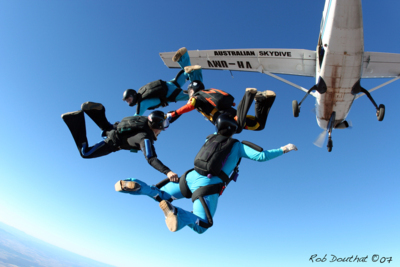Recommended Posts
Jiggs 0
Suggest that rather than speculate wait for the official report, believe that a preliminary will be out tomorrowish with the salient points.
"Don't blame malice for what stupidity can explain."
"In our sleep, pain that cannot forget falls drop by drop upon the heart and in our despair, against our will comes wisdom" - Aeschylus
"In our sleep, pain that cannot forget falls drop by drop upon the heart and in our despair, against our will comes wisdom" - Aeschylus
TomAiello 26
Actually, I think Tim was trying to speculate on what might go wrong with a system that had incompatible pieces. I think he was very consciously trying to steer away from discussion of a specific incident (hence his removal of this discussion from the incidents forum).
-- Tom Aiello
Tom@SnakeRiverBASE.com
SnakeRiverBASE.com
Tom@SnakeRiverBASE.com
SnakeRiverBASE.com
Thanks Tom.
Apart from learning from a tragedy, which the specific details in time will become clearer in the 'incident' forum, the issue here is about 'compatibility'.
First and foremost, the rig is a 'system' of components that are engineered and designed to work together - and swapping bits between rigs may or may not present a hazard.
Why is this relevant? For three reasons that I can think of.
The new jumper who buys second hand gear, or buys bits and pieces to go together. Second hand gear may be subject to SBs and need attention; or the container may not be suitable for the canopies; or the bits (risers for example) may simply be a wrong fit. This is of course what rigger's are for - but it certainly doesn't hurt if jumpers are a tiny bit informed.
Secondly, the jumper that chops a main, and is up for a new main deployment bag and risers (yeah, and a main), and a freebag (hell, even handles on a bad day!). Things like freebags, main deployment bags(?), risers should be manufacturer specific (in fact, the freebag is TSOd so it has to be?). Even something as mundane as toggles are matched to the riser!
Finally, there is the jumper who is downsizing - more and more common. Rigs are built to take a certain size range of canopies - most manufacturers list the sizes for each container on their websites - and most say that going down a size is acceptable. Go any smaller, and you then may have compatibility issues.
Apart from learning from a tragedy, which the specific details in time will become clearer in the 'incident' forum, the issue here is about 'compatibility'.
First and foremost, the rig is a 'system' of components that are engineered and designed to work together - and swapping bits between rigs may or may not present a hazard.
Why is this relevant? For three reasons that I can think of.
The new jumper who buys second hand gear, or buys bits and pieces to go together. Second hand gear may be subject to SBs and need attention; or the container may not be suitable for the canopies; or the bits (risers for example) may simply be a wrong fit. This is of course what rigger's are for - but it certainly doesn't hurt if jumpers are a tiny bit informed.
Secondly, the jumper that chops a main, and is up for a new main deployment bag and risers (yeah, and a main), and a freebag (hell, even handles on a bad day!). Things like freebags, main deployment bags(?), risers should be manufacturer specific (in fact, the freebag is TSOd so it has to be?). Even something as mundane as toggles are matched to the riser!
Finally, there is the jumper who is downsizing - more and more common. Rigs are built to take a certain size range of canopies - most manufacturers list the sizes for each container on their websites - and most say that going down a size is acceptable. Go any smaller, and you then may have compatibility issues.
Quoteand allowing heavier jumpers to safely use "regular" mini risers.
Lisa, is there still a 220 or 225# limit on the mini-risers?
riggerrob 644
Sure would be easier to analyze this hard cutaway if we had the official report.
There are several scenarios where it would be difficult to pull the cutaway handle:
riser geometry
housing length
cable pinch
If riser geometry is incorrect, i.e. rings improperly spaced, they can put too much pressure on the cable.
If the housing is too short i.e. mini-force risers installed on a harness with release housings that were on the short side to begin with, the housing can apply tension to the white nylon loop.
Finally, if the main spins up too fast, it can twist the risers so tightly around the release cables that they are impossible to pull.
Just my three bits of speculation.
There are several scenarios where it would be difficult to pull the cutaway handle:
riser geometry
housing length
cable pinch
If riser geometry is incorrect, i.e. rings improperly spaced, they can put too much pressure on the cable.
If the housing is too short i.e. mini-force risers installed on a harness with release housings that were on the short side to begin with, the housing can apply tension to the white nylon loop.
Finally, if the main spins up too fast, it can twist the risers so tightly around the release cables that they are impossible to pull.
Just my three bits of speculation.
For anyone looking for some background info on the subject of cutting away and riser design, check out this link....
http://www.bpa.org.uk/skydive/pages/articles/dec03/cutting-away.html
Useful for newbies, less so for most riggers and experienced people.
http://www.bpa.org.uk/skydive/pages/articles/dec03/cutting-away.html
Useful for newbies, less so for most riggers and experienced people.
--------------------
He who receives an idea from me, receives instruction himself without lessening mine; as he who lights his taper at mine, receives light without darkening me. Thomas Jefferson
He who receives an idea from me, receives instruction himself without lessening mine; as he who lights his taper at mine, receives light without darkening me. Thomas Jefferson
Atom Harnesses have the Main ring located higher up the main
lift web. Reverse risers are not a problem as this harness is
designed to be compatible.
If you fit these risers to another harness, like a Vector
or Javelin, it is highly likely the reverse risers will not
release if cutaway in a low drag malfunction, like a baglock,
where the body is still belly to earth. The angle between the main
webbing and the riser causes the reversed ring to press against
the harness, thus locking the 3 ring system. This can be easily
demonstrated on the ground. It's usually the middle ring that gets
jammed.
This is a problem that surfaced many years ago when some
people chose to fit Atom risers to their rigs because they liked
the idea of the velcroless brake set up.
lift web. Reverse risers are not a problem as this harness is
designed to be compatible.
If you fit these risers to another harness, like a Vector
or Javelin, it is highly likely the reverse risers will not
release if cutaway in a low drag malfunction, like a baglock,
where the body is still belly to earth. The angle between the main
webbing and the riser causes the reversed ring to press against
the harness, thus locking the 3 ring system. This can be easily
demonstrated on the ground. It's usually the middle ring that gets
jammed.
This is a problem that surfaced many years ago when some
people chose to fit Atom risers to their rigs because they liked
the idea of the velcroless brake set up.
Kiss my dogs arse.
MULTIS 0
Isn't still so that if you install a different main. The riggers yearly safety check is void?
And therefore illegal to jump with.
And therefore illegal to jump with.
TomAiello 26
QuoteIsn't still so that if you install a different main. The riggers yearly safety check is void?
And therefore illegal to jump with.
That depends on the country you are jumping in, I think.
-- Tom Aiello
Tom@SnakeRiverBASE.com
SnakeRiverBASE.com
Tom@SnakeRiverBASE.com
SnakeRiverBASE.com
BigMark 1
Just purchased a rig that had a mini ring harness with large ring risers, the risers would not release without yanking and shaking them.
riggerrob 644
QuoteJust purchased a rig that had a mini ring harness with large ring risers, the risers would not release without yanking and shaking them.
.................................................................................
You silly boy!
Reach for a larger hammer!
Hah!
Hah!




Yes, but I'm on a ski vacation with my kids. Equipment compatibility is a big subject, which I don't have time to go into right now. However, on reversed (Integrity) risers...The scariest stories I've heard about them happen in two canopy out situations. Often, the main risers are held back across the shoulders, preventing the unfortunate jumper from cutting the main away in a "personal downplane" situation.
Reversed risers offer no advantages, have lower mechanical advantage, have no published construction or inspection specifications (so you can't tell if they are going to work in a high "G" situation), and can kill you in the above situation (and others). They should be replaced, and you should get very mad at anyone who sold them to you. The same is true for most "soft housing" 3-ring release systems. More later...
Share this post
Link to post
Share on other sites